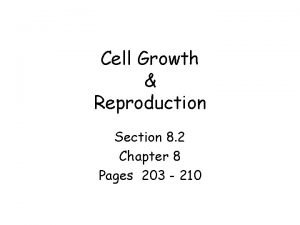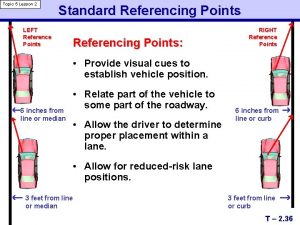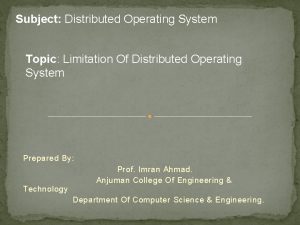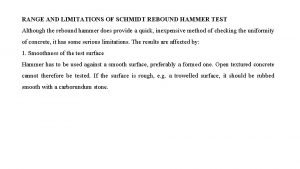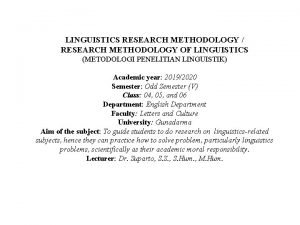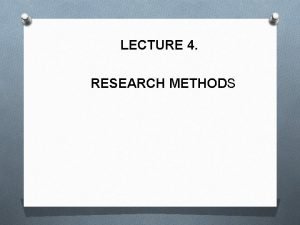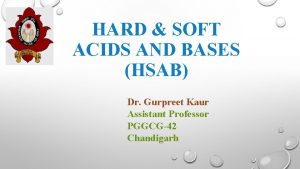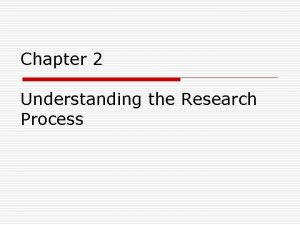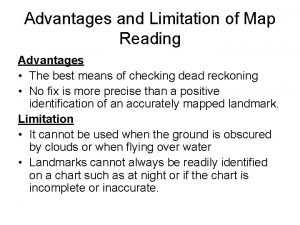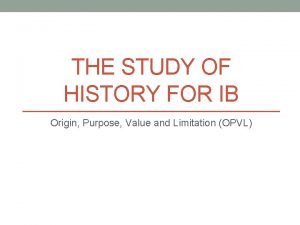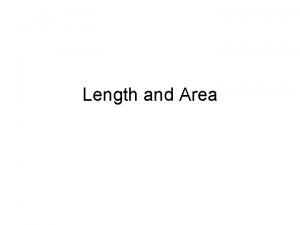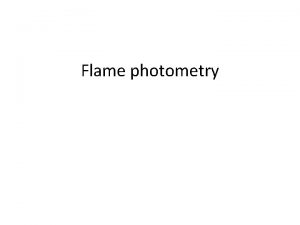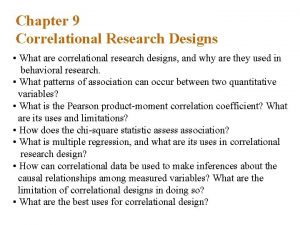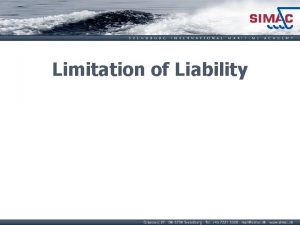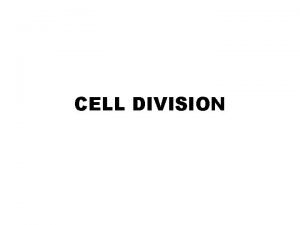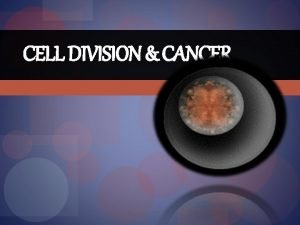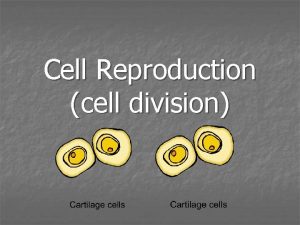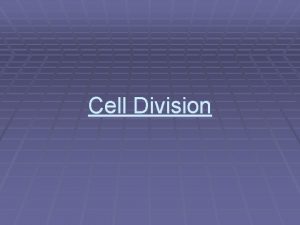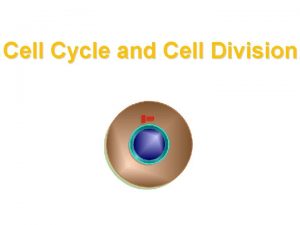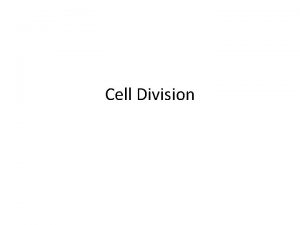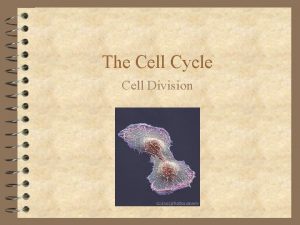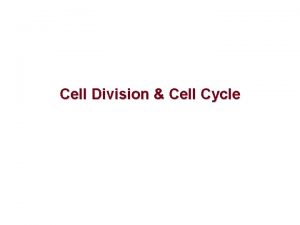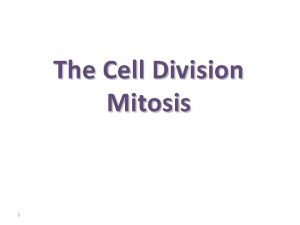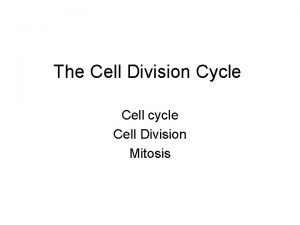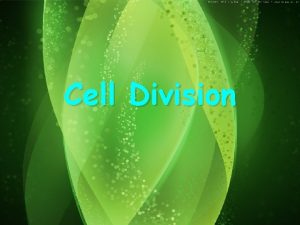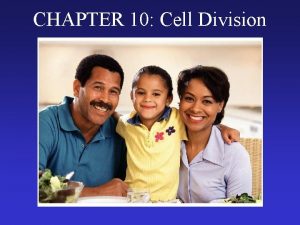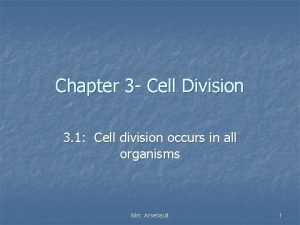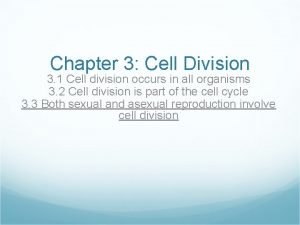Cell Division Chapter 10 Cell Limitation As Cell



























- Slides: 27

Cell Division Chapter 10

Cell Limitation �As Cell Grows: �Stops growing before too large �It divides, forming two cells

Cell Division Process by which the cell divides into two new daughter cells.

Chromosomes Carries genetic information that is passed from one generation of cells to the next DNA only visible during cell division every organism has a specific number

Terms Sister Chromatids: two identical copies of the chromosome Centromeres: attaches the chromatids together.


series of events that cells go through as they grow and divide Interphase: period of the growth of the cell M phase Cell Cycle

Interphase • Divided into three phases: • G 1 (growth) • S (replication of DNA) • G 2 (preparation for mitosis)

Mitosis �Divided into four phases: �Prophase �Metaphase �Anaphase �telophase

Prophase Chromatin condenses Centrioles separate Spindle begins to form Nuclear envelope breaks down

Metaphase Chromosomes line up across center Spindle fiber connected to centromere

Anaphase Sister chromatids separate into chromosomes Sister chromatids move apart

Telophase �Chromosomes gather at opposite ends �Chromosomes lose distinct shape � 2 nuclear envelopes form

Cytokinesis (splitting into two) �occurs at the same time as telophase. �Animals: The cell membrane is drawn inward until it is pinched into �Plants: cell plate forms midway between the cell

Cell Cycle Regulators �Tells cells when it is time to divide and duplicate chromosomes �Cyclin: protein that regulates the timing of the cell cycle in eukaryotic cells �Two different types: �Internal Regulators �External Regulators

Internal Regulators �Proteins that respond to events inside the cell �Allow the cell cycle to proceed only when certain processes have happened inside the cell. �EX: some regulators make sure that a cell does not enter mitosis until all its chromosomes have been replicated.

External Regulators �Proteins that respond to events outside the cell �Direct cells to speed up or slow down the cycle. �Growth factors: stimulate the growth and division of cells. �Prevent extensive cell growth and keep the tissues of the body from disrupting each other

Uncontrolled Cell Growth �Cancer: �cells lose the ability to control growth. �Does not respond to the signals that regulate the growth �Form tumors

�Benign: not cancerous �Malignant: Cancerous

Meiosis �Terms: �Homologous: each of the chromosomes that come from the male parent and female parent. �Diploid (2 N): contains both sets of homologous chromosomes (two sets). �Haploid (N): contains only a single set of chromosomes (single set)

Meiosis �the number of chromosomes is cut in half �Two cell divisions: Meiosis I and Meiosis II �End Result: 4 haploid cells

Meiosis I Interphase I Prophase I: chromosomes pair with its corresponding homologous chromosome Crossing over Metaphase I, Anaphase I, Telophase I


Meiosis II �second meiotic division �Prophase II: Neither cell goes through a round of chromosome replication �Metaphase II, Anaphase II, Telophase II


Gamete Formation: Males: sperm Produces 4 haploid sperm cells Females: eggs Produces 1 haploid egg cell Receives most of the cytoplasm Polar bodies

Mitosis and Meiosis Results: two genetically identical diploid cells Begins with a diploid cells and ends with a diploid cell Involved in asexual reproduction Results: four genetically different haploid cells. Begins with a diploid cell and ends with a haploid cell Involved in sexual reproduction
 Events of the cell cycle
Events of the cell cycle Cell cycle and cell division
Cell cycle and cell division Cell cycle phases
Cell cycle phases Chapter 8 cell growth and division section 8-2 answer key
Chapter 8 cell growth and division section 8-2 answer key Long division and short division
Long division and short division What is the missing number in the synthetic-division array
What is the missing number in the synthetic-division array Division traditional method
Division traditional method Synthetic.division
Synthetic.division Contoh pembatasan kecacatan
Contoh pembatasan kecacatan Lane position 1-4
Lane position 1-4 Limitation of distributed system
Limitation of distributed system Significance of study sample
Significance of study sample Limitations of rebound hammer test
Limitations of rebound hammer test Origin purpose value limitation examples
Origin purpose value limitation examples Title of research example
Title of research example Significance of the study example
Significance of the study example Explain pearson's hsab concept
Explain pearson's hsab concept Research process steps
Research process steps Linear search advantages and disadvantages
Linear search advantages and disadvantages Limitation of maps
Limitation of maps Opvl structure
Opvl structure Accuracy limits
Accuracy limits Coplanar concurrente funcion
Coplanar concurrente funcion Applications of flame photometry slideshare
Applications of flame photometry slideshare Limitations of the study examples
Limitations of the study examples Limitation of correlational research
Limitation of correlational research Limitations of a student
Limitations of a student Which is one limitation to technological design
Which is one limitation to technological design



